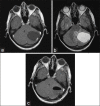Surgical resection of sporadic and hereditary hemangioblastoma: Our 10-year experience and a literature review
- PMID: 25317353
- PMCID: PMC4192902
- DOI: 10.4103/2152-7806.141469
Surgical resection of sporadic and hereditary hemangioblastoma: Our 10-year experience and a literature review
Abstract
Background: Hemangioblastomas (HBLs) are benign neoplasms that contribute to 1-2.5% of intracranial tumors and 7-12% of posterior fossa lesions in adult patients. HBLs either evolve hereditarily in association with von Hippel-Lindau disease (vHL) or, more prevalently, as solitary sporadic tumors. Only few authors have reported on the clinical presentation and the neurological outcome of HBL.
Methods: We retrospectively analyzed the clinical, radiological, surgical, and histopathologic records of 24 consecutive patients (11 men, 13 women; mean age 51.3 years) with HBL of the posterior cranial fossa, who had been treated at our center between 2001 and 2012. We reviewed the current literature, and discussed our findings in the context of previous publications on HBL. The study protocol was approved by the local ethics committee (14-101-0070).
Results: Mean time to diagnosis was 14 weeks. The extent of resection (EOR) was total in 20 and near total in 4 patients. Four patients required revision within 24 h because of relevant postoperative bleeding. One patient died within 14 days. One patient required permanent shunting. At discharge, 75% of patients [n = 18, modified Rankin scale (mRS) 0-1] showed no or at least resolved symptoms. Mean follow-up was 21 months. Two recurrences were detected during follow-up.
Conclusions: In comparison to other benign entities of the posterior fossa, time to diagnosis was significantly shorter for HBL. This finding indicates the rather aggressive biological behavior of these excessively vascularized tumors. In our series, however, the rate of complete resection was high, and morbidity and mortality rates were within the reported range.
Keywords: CNS hemangioblastoma; neurological outcome; posterior cranial fossa; von Hippel–Lindau disease.
Figures




References
-
- Ahyai A, Woerner U, Markakis E. Surgical treatment of intramedullary tumors (spinal cord and medulla oblongata).Analysis of 16 cases. Neurosurg Rev. 1990;13:45–52. - PubMed
-
- Baker KB, Moran CJ, Wippold FJ, 2nd, Smirniotopoulos JG, Rodriguez FJ, Meyers SP, et al. MR imaging of spinal hemangioblastoma. AJR Am J Roentgenol. 2000;174:377–82. - PubMed
-
- Bing F, Kremer S, Lamalle L, Chabardes S, Ashraf A, Pasquier B, et al. Value of perfusion MRI in the study of pilocytic astrocytoma and hemangioblastoma: Preliminary findings. J Neuroradiol. 2009;36:82–7. - PubMed
-
- Burger PC, Scheithauer BW. Fascicle. Vol. 7. Washington DC: ARC Press; 2007. Hemangioblastoma. Tumors of the central nervous system, AFIP atlas of tumor pathology; pp. 309–20. (4th series).
-
- Capitanio JF, Mazza E, Motta M, Mortini P, Reni M. Mechanisms, indications and results of salvage systemic therapy for sporadic and von Hippel-Lindau related hemangioblastomas of the central nervous system. Crit Rev Oncol Hematol. 2013;86:69–84. - PubMed
Publication types
LinkOut - more resources
Full Text Sources
Other Literature Sources
Research Materials

